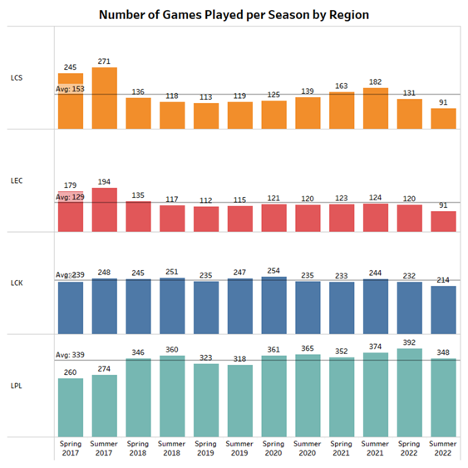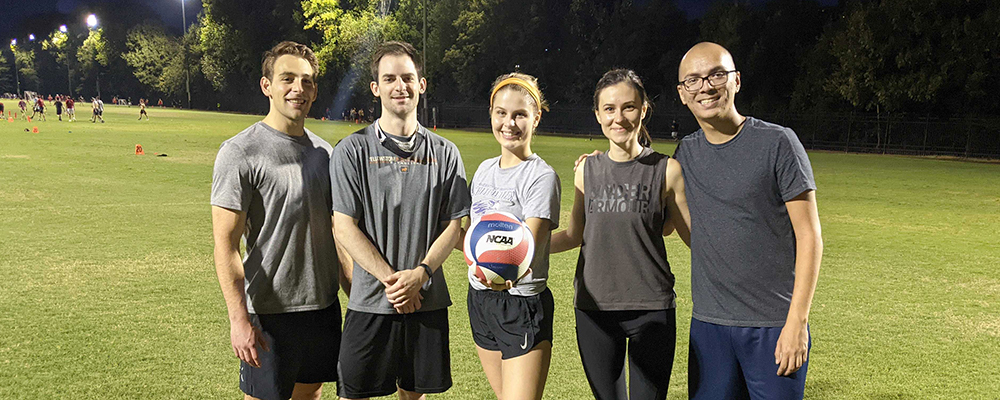When learning any skill, we often hear the classic phrase “Practice makes perfect.” However, that phrase is frequently replaced with “Only perfect practice makes perfect.”
Perfect practice doesn’t mean that we avoid mistakes and errors when practicing – we’re only human, after all. Instead, perfect practice is deliberate practice. Practice where we are allowed to experiment, to make mistakes, and to explore the edges of our abilities.
The same holds in professional League of Legends, an e-sport I’ve loved watching since I was in middle school.
In the world of e-sports analytics, there are numerous data science applications. Those applications range from using a logistic regression model to explain what factors lead a team to win, image processing to track player movement across the map, or simple bar charts to show a clear divide in practice opportunities.
In this blog post, I’ll show how professional League of Legends teams from South Korea and China play 148 more games per season on average than North American and European teams. It should be no surprise that South Korea and China have won nearly every single international tournament since the inception of professional play. Therefore, I recommend that North American and European leagues switch from a Best Of 1s (BO1) to a Best Of 3s (BO3s) format to be internationally competitive using the idea of perfect practice.
League of Legends is a Mobile Online Battle Arena (MOBA) released in 2009 that has attracted a large competitive audience and eventually the formation of professional esports teams. In 2011, the first League of Legends World Championship was held in Sweden, featuring North American, European, and Southeast Asian teams.
A European team, Fnatic, was the first team ever to win the League of Legends World Championship. Since then, no Western team has ever been able to claim that title.
There are four major regions:
- League of Legends Championship Series (LCS) is held in North America.
- League of Legends European Series (LEC) is held in Europe.
- League of Legends Champions Korea (LCK) is held in South Korea.
- League of Legends Pro League (LPL) is held in China.
There are minor regions such as League of Legends Japan (LJL), Turkish Championship League (TCL), and Vietnam Championship Series (VCS). However, these regions generally have poor representation at international events because they can only send one to two teams, while major regions can send three to four teams. For the sake of my analysis, I only considered the four major regions.
To investigate the number of games played per session by region, I pulled data from Oracle’s Elixir to look at match data. Then I plotted the data as shown in the figure below:

The LCS and LEC do not play as many games as the LCK and LPL. If we take the average number of games played between the LCK and LPL, these two regions play 289 games per season. Compared to the average number of games played between the LCS and LEC, these two regions play 141 games per season – a 148-game statistically significant difference.
Teams from the LCS and LEC don’t play as many games as the LCK and the LPL, so they have fewer practice opportunities. Like any other sport, professional League of Legends teams play against other teams in their respective regions during the spring and summer, which is called the regular season. At the end of each regular season, teams with the most wins from the regular season compete in playoffs to fight for a regional title and a spot to represent the region in an international tournament.
During the regular season, LCS and LEC teams play BO1s, while LCK and LPL teams play BO3s. Clearly, this will create a discrepancy in the number of games played per season across regions.
In a BO1, all the stakes are on that one game. Teams must play to their peak to win. However, the stakes are different in a BO3. While teams are still aiming to win, teams have up to three games to try other strategies and experiment.
One format requires perfect play, and the other allows for perfect practice.
Perfect practice means better players, better teams, and better chances of taking down international teams and winning international titles.
Of course, it should be acknowledged that the goal of some teams is to win domestically. However, the sponsors behind teams invest in them so they can get their names in front of more viewers, and it should be no surprise that international events have the highest viewer count because they feature the best of the best.
Scrims (matches played between two teams to simulate a competitive match) against other teams and champion’s queue (a way for pros to be teamed up and go against other players in and out of their own teams) can only do so much.
If the LCS and LEC want to be competitive against the LCK and LPL, these two leagues should adopt the BO3 format during the regular season, so players have more opportunities to experiment in on-stage games.
If we want to perform the best, we must practice like the best.
We should try to replicate the exact environment we need to perform in. This allows us to practice in those conditions over and over.
We can make mistakes. We can go through trial and error. We can figure out what works and what doesn’t.
Whether it’s a formal business presentation, programming a game of tic-tac-toe, or competing at the highest level of a video game, only perfect practice makes perfect.
Columnist Justin De La Rosa
